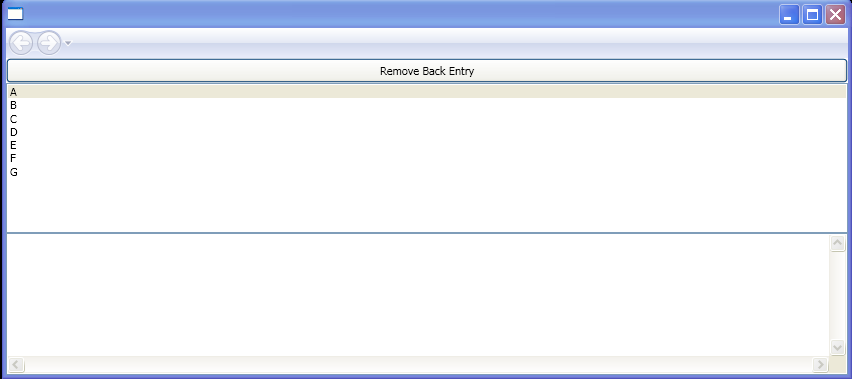<Page xmlns="http://schemas.microsoft.com/winfx/2006/xaml/presentation"
xmlns:x="http://schemas.microsoft.com/winfx/2006/xaml"
x:Class="CustomContentStateNavigationSample.StateNavigationPage"
xmlns:ns="clr-namespace:CustomContentStateNavigationSample">
<DockPanel>
<DockPanel.Resources>
<ObjectDataProvider x:Key="usersDataSource" ObjectType="{x:Type ns:Users}"/>
<DataTemplate x:Key="NameTemplate">
<TextBlock Text="{Binding Path=Name}"/>
</DataTemplate>
</DockPanel.Resources>
<Button Name="removeBackEntryButton" DockPanel.Dock="Top" Click="removeBackEntryButton_Click" Height="25">Remove Back Entry</Button>
<ListBox Name="userListBox" DockPanel.Dock="Top" Height="150" SelectionChanged="userListBox_SelectionChanged" DataContext="{StaticResource usersDataSource}" ItemsSource="{Binding}" IsSynchronizedWithCurrentItem="True" ItemTemplate="{StaticResource NameTemplate}" />
<ListBox Name="logListBox" ScrollViewer.CanContentScroll="True" ScrollViewer.HorizontalScrollBarVisibility="Visible" ScrollViewer.VerticalScrollBarVisibility="Visible"></ListBox>
</DockPanel>
</Page>
//File:Window.xaml.cs
using System;
using System.Collections.ObjectModel;
using System.Windows;
using System.Windows.Controls;
using System.Windows.Navigation;
using System.Collections.Generic;
using System.Text;
namespace CustomContentStateNavigationSample
{
public partial class StateNavigationPage : Page, IProvideCustomContentState
{
void removeBackEntryButton_Click(object sender, RoutedEventArgs e)
{
if (this.NavigationService.CanGoBack)
{
JournalEntry entry = this.NavigationService.RemoveBackEntry();
UserCustomContentState state = (UserCustomContentState)entry.CustomContentState;
this.logListBox.Items.Insert(0, "RemoveBackEntry: " + state.JournalEntryName);
}
}
internal void userListBox_SelectionChanged(object sender, SelectionChangedEventArgs e)
{
if( e.RemovedItems.Count == 0 ) return;
User previousUser = e.RemovedItems[0] as User;
this.logListBox.Items.Insert(0, "AddBackEntry: " + previousUser.Name);
UserCustomContentState userPageState = new UserCustomContentState(previousUser);
this.NavigationService.AddBackEntry(userPageState);
}
CustomContentState IProvideCustomContentState.GetContentState()
{
User currentUser = this.userListBox.SelectedItem as User;
this.logListBox.Items.Insert(0, "GetContentState: " + currentUser.Name);
return new UserCustomContentState(currentUser);
}
}
public class User
{
private string name;
public User() { }
public User(string name)
{
this.name = name;
}
public string Name
{
get { return name; }
set { name = value; }
}
}
[Serializable]
class UserCustomContentState : CustomContentState
{
private User user;
public UserCustomContentState(User user)
{
this.user = user;
}
public override string JournalEntryName
{
get
{
return this.user.Name;
}
}
public override void Replay(NavigationService navigationService, NavigationMode mode)
{
StateNavigationPage page = (StateNavigationPage)navigationService.Content;
ListBox userListBox = page.userListBox;
page.userListBox.SelectionChanged -= page.userListBox_SelectionChanged;
page.userListBox.SelectedItem = this.user;
page.userListBox.SelectionChanged += page.userListBox_SelectionChanged;
}
}
public class Users : ObservableCollection<User>
{
public Users()
{
this.Add(new User("A"));
this.Add(new User("B"));
this.Add(new User("C"));
this.Add(new User("D"));
this.Add(new User("E"));
this.Add(new User("F"));
this.Add(new User("G"));
}
}
}
